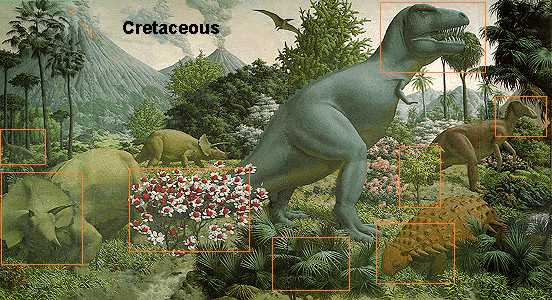
This last chapter of the Age of Reptiles began quietly enough with most of the land areas of the world steaming under near-tropical conditions and much of the country lying at only moderate elevations or quite close to sea level. By the close of the Cretaceous interval, however, mountain building once again dominated several regions of the world. Our own Rocky Mountains were pushed up during the last stages of the Cretaceous. This event is symbolized in the background of the Cretaceous section of the Zallinger mural. Amid this scene of upheaval appeared a variety of dinosaurs -- nearly all of them new and all descended from the various types that had been common during the Jurassic.
The last major development in the evolution of land plants occurred with the appearance of flowering plants sometime around the beginning of the Cretaceous period. Within a span of some 5O million years, well before the dinosaurs became extinct, the flowering plants, or angiosperms, had risen to dominate the earth's flora and had changed its ecology in fundamental ways. The unique extent to which flowering plants depend upon insects, birds, and small mammals to carry their pollen and distribute their seeds has brought them into close coevolutionary relationships with these animals. As a result of the nearly infinite possibilities for variation that this provides, flowering plant species now outnumber all other land plants by twenty or thirty to one. They are also overwhelmingly dominant as the source of our food energy, both directly and as feed for the animals that we consume.
It is with this Cretaceous plant record that major discrepancies between the mural and what is currently accepted in scientific circles occur, because of important advances that have taken place in the understanding of the Cretaceous plant record over the more than forty years since the completion of The Age of Reptiles. In fact, one of the real paradoxes of the mural's final scene is that although all the animals belong to extinct forms, all the plants are members of modern genera. When the mural was completed, the prevailing scientific view, based on the then-current understanding of leaf remains, was that the Cretaceous angiosperm flora was moderately advanced and the opening chapters of its history must have transpired much earlier and in settings, such as mountain regions, where erosion would have precluded their preservation. Later research has disproved this, showing instead that Cretaceous angiosperms, especially those from the early part of the period, were truly primitive and belonged to archaic groups only distantly related to those that make up the flora of the modern world.